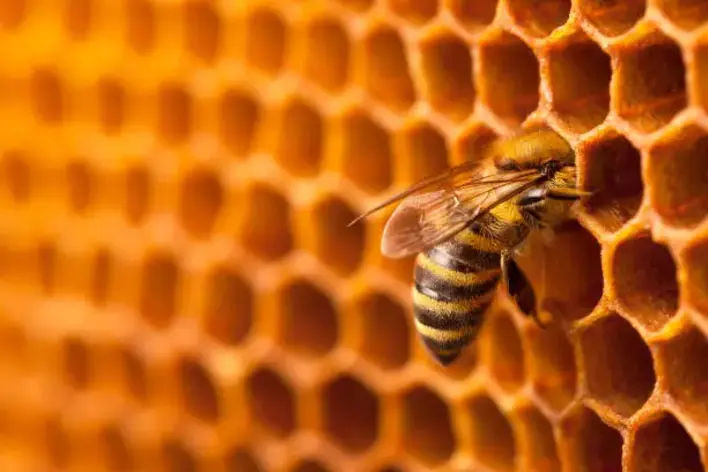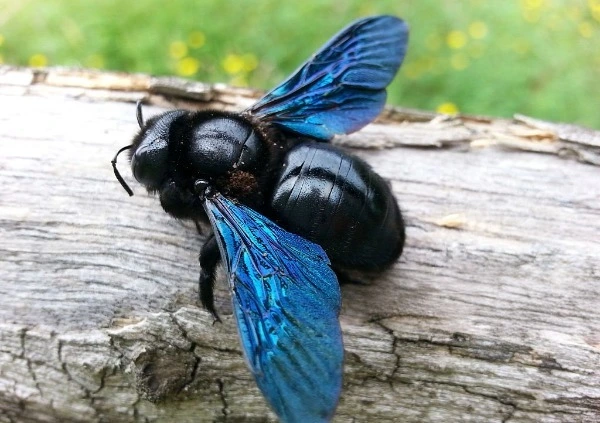What is Honeycomb?
A honeycomb is a structure made by bees using wax, featuring hexagonal cells where honey is stored. This hexagon shape is nature’s efficient design, allowing bees to store their food in a strong and organized way.

Characteristics of Honeycomb
| Characteristics | Description |
| Color | Varies based on the type of honey, ranging from light to dark |
| Texture | Waxy and smooth, with hexagonal cells. |
| Flavor | Reflects the floral source of the honey; can be mild to robust. |
| Aroma | Aromatic, often carrying the scent of the flowers visited by bees. |
| crystallization | May crystallize over time, forming a fine-grained texture. |
| Consistency | Firm yet pliable, breaks easily when cut. |
| Nutritional Content | Rich in carbohydrates, antioxidants, vitamins, and minerals. |
| Pollen Content | May contain traces of pollen from the flowers visited by bees. |
| Enzymes | Contains natural enzymes, including invertase and diastase. |
| Water Content | Generally low, contributing to the honey’s preservation. |
| Antibacterial Properties | Natural antimicrobial properties inhibit bacterial growth. |
| Crunchiness | May have a slightly crunchy texture due to pollen particles. |
| Source | Derived from the nectar of flowers collected by honeybees. |
| Storage Conditions | Best stored in a cool, dry place to prevent crystallization. |
| Uses | Culinary applications, medicinal purposes, sweeteners in various dishes. |
| Harvesting Method | Harvested from beehives after bees cap the honey-filled cells. |
| Transparency | Varies, with some honeycombs allowing light to pass through. |
| Cultural Significance | A Honeycomb symbolizes nature’s intricate design and sweetness. |
The Basics of Honeycomb
Wondered about the neat structure of a honeycomb and what makes it so fascinating? Let’s break it down.
1. Hexagonal Marvel: A Bee’s Handiwork
Honeycomb cells are hexagons – six-sided wonders created by bees. It might sound fancy, but it’s nature’s way of being efficient. Bees build these hexagons with beeswax, and it’s a genius design for storing honey.
2. Busy Builders: Meet the Worker Bees
Worker bees are the architects behind honeycomb. Using beeswax from their bodies, they construct each cell with precision. Teamwork is the key, and the result is a beautiful honey storage system.
3. Honey Production 101: From Nectar to Honeycomb
Wondering how honey gets into those cells? Bees collect nectar from flowers, bring it back to the hive, and deposit it into the honeycomb. Through a natural process of evaporation, water content decreases, and boom – honey is born!
4. Multi-Purpose Compartments: More Than Just Honey
It isn’t just for honey. Bees use it as a storage unit for pollen, royal jelly, and bee bread. It’s like a pantry for the hive, neatly organizing essential goodies.
5. Natural Shield: Preserving Honey the Bee Way
It acts like a protective shield for honey. The wax cells keep honey safe from contaminants, making sure it stays pure and delicious. Bees are like the original food scientists!
6. Harvesting Honeycomb: A Delicate Dance
Humans have been harvesting it for ages. It involves carefully taking the comb from the hive with minimal disruption. It’s a careful process – a dance between humans and bees – resulting in the tasty treat we all love.
Conclusion
Next time you enjoy honey or marvel at honeycomb, remember the incredible journey from the buzzing hive to your table. Nature’s genius is not just in the taste but in the simple wonders around us. it is a true marvel in every bite!
FAQs
What is the best way to eat honeycomb?
Answer: The simplest way to eat it into slice a thin piece with a knife or carve out a spoonful and eat it raw. Some people prefer to spit it out like gum, the wax is chewy and edible. It is a pleasure devoid of guilt. Following are some recipes that you should try:
12 Delicious Ways to Boost Your Immunity With Honeycomb
What is a honeycomb made out of?
Answer; Wax is extruded from glands in worker bee abdomens to create honeycomb.
Is it ok to eat honeycomb?
Answer: Absolutely! You can munch on the honeycomb just like bees do. It’s a bit chewy, and some people love the taste. Plus, it’s a cool way to enjoy honey in its natural home.
Why is honeycomb hexagonal?
Answer: Hexagons are nature’s efficient design. The bees use less wax to create stronger and more organized cells, making hexagons the perfect shape for honeycomb.
Is honeycomb only made for honey storage?
Answer: Honey storage is the primary purpose; it also serves as a home for bee larvae and provides structural support for the hive.
How long does a honeycomb last?
Answer: Properly stored, it can last indefinitely. Its natural preservation properties, such as hygroscopy and the sealing of wax cells, contribute to its long shelf life.
Can you reuse honeycomb?
Answer: Bees often reuse it within their hive. Once removed from the hive, it’s challenging to reuse it in the same way. Some people use empty honeycomb as natural beeswax candles or decorations.
Why does honeycomb sometimes crystallize?
Answer: Crystallization is a natural process in honey. It occurs when glucose in the honey separates from water, forming crystals. Gently warming the honeycomb can return it to its liquid state.
How should I store honeycomb at home?
Answer: Store it in a cool, dry place away from direct sunlight. This helps maintain its freshness and prevents the wax from melting. If stored properly, it can stay good for a long time.
How do bees choose where to build honeycomb?
Answer: Bees select locations in the hive based on factors like temperature, humidity, and proximity to the brood (young bees).
What does it taste like?
Answer: The flavor of it comes from the nectar collected by bees from flowers. Different flowers contribute to the unique taste of the honey.
Can you eat the wax in a honeycomb?
Answer: Yes, the beeswax in it is safe to eat. It’s a natural product, some people prefer not to consume large amounts due to its waxy texture.
Is honeycomb good for you?
Answer: Yes, It is great for you! It’s a natural sweetener full of antioxidants that keep you healthy. Being raw and unprocessed, it’s better than refined sugars. Read more





